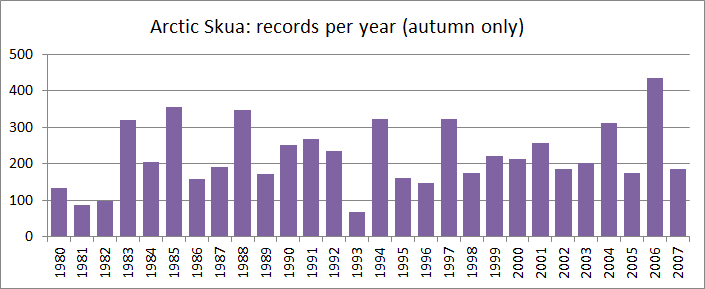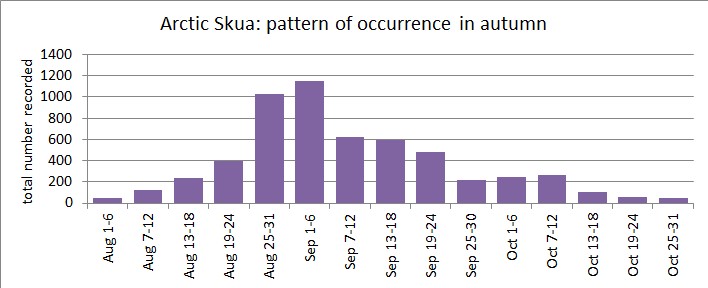Stercorarius pomarinus .
The Arctic breeding range of the Pomarine Skua is almost circumpolar, being mainly correlated with the variable distribution of Lemmings. Migrants seen in north-west Europe are en route to or from wintering areas off west Africa, which lie largely north of the Equator.
The Pomarine Skua was first recorded for Pembrokeshire by Mathew (1894), who commented “a few are to be seen every autumn, and after heavy gales large flocks are observed.” Lockley et al (1949) considered he could have been wrong, as they knew of only four occurrences during their time, the only one dated being on the 21st September 1930.
There were seven records involving 11 birds during the next 28 years. With the exception of 1979 they have been recorded annually since 1976. Most were seen in the autumn, between August and December and predominantly at Strumble Head.

N. B. The discrepancy between the 1991 total and that given by Donovan and Rees (1994) is because of additional records received since publication of that work.

Totals August to November 1980 – 2006.Values are expressed in six day intervals, the last period in months of 31 days have been adjusted from seven day totals by dividing by seven and multiplying by six.
Daily totals were small, normally involving less than 20 birds, with the following exceptions: 22 on the 20th October 1984, 30 on the 10th November 1985, 59 on the 7th October 1988, 97 on the 17th October 1991, 130 on the 18th October 1991, 20 on the 4th September 1992, 24 on the 20th October 1999, 27 on the 6th November 1999 and 21 on the 4th December 1999.
There were only six other bird days recorded in the month of December over the whole period from 1980 to 2006, the latest being on the 27th in 1990 and 1999. Early occurrences were of single birds on the 21st and 22nd July 1990 and 24th July 1998.
Away from Strumble Head, autumn records of one to four birds were noted off Fishguard, from the Fishguard to Rosslare ferry, Ramsey, Newgale, The Smalls, in the Celtic Deep, Skomer, Skokholm, St Govan’s Head and Amroth, with 11 at St David’s Head on the 5th November 1999.
Graham Rees
(Covers records up to and including 2006)
References
DONOVAN. J and REES. G. 1994. Birds of Pembrokeshire, Dyfed Wildlife Trust.
LOCKLEY. R. M, INGRAM. C. S. and SALMON. H. M.1949. The birds of Pembrokeshire, West Wales Field Society.
MATHEW. M. 1894. The birds of Pembrokeshire and its islands, R. H. Porter
 Saturday, November 27, 2010 at 10:13AM
Saturday, November 27, 2010 at 10:13AM  GHR,
GHR,  Skua,
Skua,  seabird in
seabird in  Arctic Skua
Arctic Skua 




